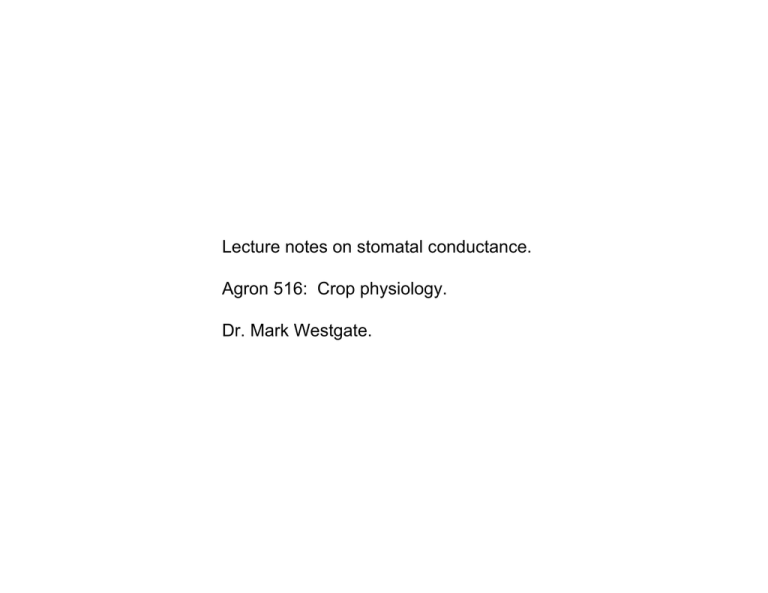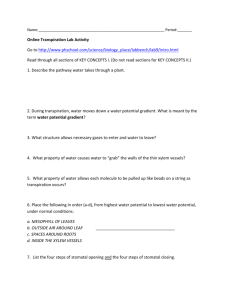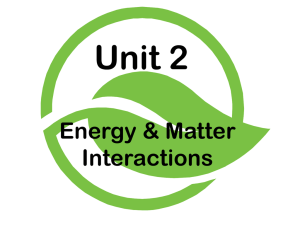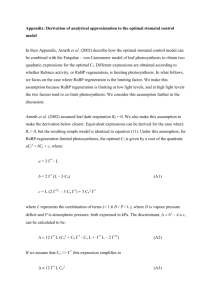Lecture notes on stomatal conductance. Agron 516: Crop physiology.
advertisement

Lecture notes on stomatal conductance. Agron 516: Crop physiology. Dr. Mark Westgate. Diurnal variation of stomatal conductance has direct consequences for leaf and canopy gas exchange Measure diurnal pattern of transpiration and photosynthesis by a corn canopy Adopted from Christy, A.L., et al. 1986 Idealized diurnal pattern of stomatal conductance at three levels of water availability Representative values of leaf conductances, RH, and water vapor affecting movement of water out of a leaf through a stomatal pore. Ψw at 25°C -1.38 MPa -7.04 MPa Fig. 8.6 P.S. Nobel -95.2 MPa 1. Stomatal conductance typically controls transpiration rate 2. Transpiration rate = stomatal conductance * ΔΨwv (air - leaf) Nobel, Fig 8.6 At 25°C, Ψwv = (137.3 MPa) * ln (RH/100) Formalizing these concepts… Flux = conductance X force Transpiration rate = leaf conductance X ΔCwv (leaf - air) r ) Jwv = g total wv * (Cias wv - Caiwv but… g stwv << g iaswv and g bl wv therefore… _ Jwv for transpiration ~ _ g stwv General components of diffusive resistance within the leaf to CO2 exchange with the atmosphere 4. Mesophyll/Chloroplast (CO2-liq) 3. Intercellular air spaces 2. Stomata 1. Boundary layer Taiz & Zeiger, Fig. 19.7 Stomata also control the rate of CO2 flux into/out of leaves Table 8.4 P.S. Nobel Again, formalizing these concepts… Flux = conductance X force Photosynthesis rate = leaf conductance X ΔCCO2 (air-leaf)* JCO = gtotal CO * (C airCO – Cchl CO ) 2 2 2 2 Noting that flux through the gaseous and liquid parts of the path are equal… g gas CO2 * (C airCO2 – Cias CO2) = gliq CO2 * (C ias CO2 – CchlCO2) And that stomata have the lowest conductance along the path… gstCO Therefore, 2 << gblCO and giasCO 2 2 JCO ~ g stCO 2 2 *gradient opposite for water vapor Calculation of internal [CO2] and water use efficiency For water vapor exchange: Jwv = g totalwv * (Ciaswv - Cairwv ) = g totalwv (eiaswv – eairwv) Patm Where Cwv = mole fraction (eg. ppm) ewv = partial pressure (eg. Pa) = Cwv * Patm For CO2 gas exchange: JCO = g gasCO * (CiasCO - CairCO ) = g gasCO (aairCO – aiasCO ) 2 2 2 2 2 2 Patm Where aCO 2 = CCO * Patm 2 2 To calculate internal [CO2]: Water vapor and CO2 diffuse along the same path… but CO2 is 60% heavier than water Therefore…. gCO2 = gwv 1.6 Substituting into the JCO 2 equation…. JCO = g 2 total wv * (aairCO – aiasCO ) 2 2 1.6 * Patm Then solve for aiasCO … 2 aiasCO 2 = aairCO – 1.6 * Patm * JCO 2 2 g totalwv To calculate Water Use Efficiency (WUE): WUE = JCO /Jwv ~ Biomass/Crop Water Use ~ Grain yield/Seasonal Transpiration 2 JCO 2 Jwv g gasCO2 * (aairCO2 – aiasCO2)/ Patm = g totalwv * (eiaswv – eairwv)/ Patm Recall that: Substituting: JCO Jwv 2 gCO2 = gwv 1.6 = (aairCO – aiasCO ) 2 2 1.6 * (eiaswv – eairwv) For C3 plants this ratio is about 1:1000, for C4 plants the ratio is about 1:400 What determines when/how stomatal open?? Open and closed stomata of Vicia faba. Taiz & Zeiger, Fig. 18.10 Guard Cell Turgor (Ca+, K+, sucrose, malate, etc.) Schematic representation of events leading to opening and closing of stomatal pores Fig. 8.2 P.S. Nobel Stomatal aperature is regulated by many ‘internal’ and ‘external’ factors: External: epidermal cell turgor apoplast pH N-nutrition xylem ABA cytokinins PAR Blue light Vapor pressure deficit CO2 Internal: Ion channel activity ATPases secondary messengers Nitric Oxide zeaxanthin CHO metabolism Diurnal change in stomatal aperature in broad bean in relation to K+ and sucrose content. Taiz & Zeiger, Fig 18.17 Stomata close when leaf Ψw decreases… Brodribb and Holbrook, 2003 Leaf hydraulic conductance can decrease rapidly at low leaf Ψw Ψp = 0 What causes the decrease in hydraulic conductance? Brodribb and Holbrook, 2003 Leaf hydraulic conductance (Kleaf) is determined by the rate of leaf re-hydration Kleaf = C * ln(Ψo/Ψf) / t How is the change in leaf hydraulic conductance related to stomatal closure? Tritcum aestivum 1. The water in the xylem is under tension (i.e. Ψpxyl < 0) 2. As leaf Ψw decreases, the tension on the water in the xylem vessels increases (i.e. Ψpxyl < < 0) 0.1 mm Eucalyptus crenulata 3. Large tensions cause embolisms to develop in the xylem vessels 4. Water flow to affected sections of the leaf decrease Then what happens?? 0.3 mm Stomatal closure is closely associated with an increase in xylem ABA content Sunflower leaves ● natural soil drying ○ ABA fed to cut leaf Zhang and Davies, 1989a xylem [ABA] increased in water stressed leaves No H2O ABA: abscisic acid ABA appears to be involved in stomata closure even before there is a change in leaf water status No H2O Maize leaves Stomata start to close before leaf water status changes WW WS Zhang and Davies, 1989b But the water status of roots in the upper part of the soil profile does change, and these roots produce Stomata start ABA No H2O to close on day 6 WW WS Root ABA content increases dramatically as the soil dries Zhang and Davies, 1989b How can the leaves remain at high Ψw when the roots are drying? No H2O Roots in the upper soil profile dry first, and produce ABA Roots lower in the profile remain hydrated, and supply the shoot with water Maize roots Open symbols: WS Closed symbols: WW 20 -100 cm 0 - 20 cm Zhang and Davies, 1989b ABA produced in dehyrdating roots in upper soil layers and transported to the shoot may enable plants to ‘anticipate’ continued soil drying by inducing stomatal closure (feed forward response). How does the ABA get to the leaves? How does the ABA get to the guard cells? What does the ABA do when it gets there? Re-distribution of ABA from the xylem during water stress - Increase in xylem pH (apoplast pH in general) converts some ABAH to ABA , which decreases uptake by the mesophyll cells, so more ABA reaches the guard cells. Taiz & Zeiger, Fig. 23.3 Cytoplasmic Ca2+ mediates ABA-induced turgor loss in guard cells J. Schroeder, et al. 2001 [high ] [low] (1, 9, 10) ABA increases Ca2+ in cytoplasm by increasing uptake, and release from vacuole (2,3,6) Ca2+ activates anion channels and K+out channels, and inhibits H+ATPase pump (4,5) Ca2+ promotes K+ release from vacuole, increases cytoplasm pH to promote K+out channels (8,9,10,11) Ca 2+ as second messenger: PLC, InsP3, cADPR, CICR systems. Sustained stomatal closure requires sucrose removal and conversion of malate to starch. PLC: phospholipase C, InsP3: inositol tri-phosphate, cADPR: cyclic ADP ribose Cytosolic Ca2+ levels oscillate! Disrupting the oscillation pattern prevents stomatal closure. Hypothesis: Ca2+ oscillations encode information required for processing closure signals ABA-induced Ca2+ oscillations in Arabidopsis guard cells expressing fluorescent dye (yellow cameleon 2.1) J. Schroeder, et al. 2001 Proposed regulators mediating guard cell response to external ABA NB: integrated involvement of transporters, pumps, sugar metabolism J. Schroeder, et al. 2001 ROS: reactive oxygen species, PP2C: protein phosphatase, --PK: protein kinases FTase: farnesyl transferase, PLD: phospholipase D, ABC: ATP-binding cassette References • Nobel, P.S. 1991. Physicochemical and environmental plant physiology. Academic Press, Inc. San Diego. • Schroeder, J.I., J.M. Kwak, and G.J. Allen. 2001. Guard cell abscicis acid signalling and engineering drought hardiness in plants. Nature 410: 327-330. • Zhang, J., and W.J. Davies. 1989. Abscisic acid produced in dehydrating roots may enable the plant to measure the water status of the soil. Plant, Cell, Environ. 12: 73-81. • Zhang, J., and W.J. Davies. 1989. Sequential response of whole plant water relations to prolonged soil drying and the involvement of zylem sap ABA I the regulation of stomatal behaviour of sunflower plants. New Phytol. 113: 167-174. • Brodribb, T.J., and N.M. Holbrook. 2003. Stomatal closure during leaf dehydration, correlation with other leaf physiological traits. Plant Physiol. 132: 2166-2173. • Christy, A.L., D.R. Williamson, and A.S. Wideman. 1986. p 11-20. In: J.C. Shannon et al (eds.) Regulation of carbon and nitrogen reduction and utilization in maize. Amer. Soc. Plant Physiol. Rockville, MD. • Taiz, L. and E. Zeiger. 1998. Plant Physiology, second edition. Sinauer Associates, Inc. Sunderland, MA.






